Wash Impression Best Practices
Wash Impression Best Practices
Wash impressions utilizing syringe material are required for partial and denture relines and rebases, and pickup impressions are required when a tooth addition is necessary on an existing partial. Below is pertinent information for various types of partials and for dentures, followed by examples of when things go wrong. Reach out to us for more information or for questions regarding your reline or tooth addition case.
Cast Partials: When taking wash impressions for relining cast partials, the partial should be picked up inside a tray, using PVS material. Ensure the partial is fully seated and that the wash syringe material flows only in the area which requires the reline or tooth addition. When looking inside the pickup impression at the wash material, you should not see any ledges where the syringe material has stopped. The borders of the wash should feather out to the surrounding area where there is not space between the intaglio of the partial and the tissue. It is important that the syringe material should include only the area in need of the addition or reline. If you look at the partial inside the pickup and the wash syringe material is all over, there’s a good chance the partial was not fully seated. Lastly, if you are adding a tooth, ensure the buccal flange of the tooth to be added has been captured inside the tray with the pickup impression.
Interim/Acrylic partials: Follow the steps discussed above for cast partials.
Flexible partials: Teeth can be added to a flexible partial only when there’s existing resin teeth on the partial next to the tooth you want to add. In other words, if you want to add #8 to an existing flexible partial, there needs to be #7 or #9 already on the partial. Otherwise, it is likely that the addition will fail soon after the addition. The adjacent tooth or teeth help anchor the new tooth into place to the existing partial. To add a tooth to a flexible partial, take a pickup impression of the partial. Make sure that the tooth to be extracted or the edentulous area, as well as the buccal side flange, are fully captured in the impression. Same as described above for cast partials, check inside the pickup impression to ensure that no excess material has flowed where it should not have. Notice that flexible clasps can be added to the adjacent tooth in the mouth when a tooth is being added to the partial. For example, if the partial has replaced 3, 4, 5 and there’s a clasp on 6, but 6 is being extracted and added to the partial, we can add a tooth to #6 and make a clasp for #7.
Dentures: When taking a wash impression inside a denture or denture try in, make a small hole in the palate for excess material to flow through. When the wash syringe material is setting up in the mouth, have the patient close down and confirm that the occlusal relationship has not been affected by the wash material. In other words, the vertical dimension should not have changed. If the wash material is too thick, it will raise the VD and cause the occlusal relationship to change. If you see that the occlusal relationship has changed, remove the material from inside the denture base and do it again, with less material.
Examples of poor wash impressions:
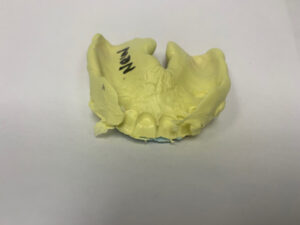
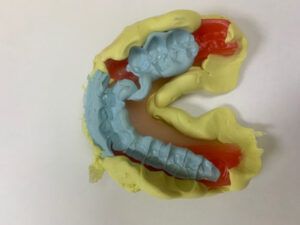
This wash impression was not picked up inside an impression tray, so the existing anterior dentition and the anterior buccal flange were not captured. This cannot be used to make a new model or proceed further.
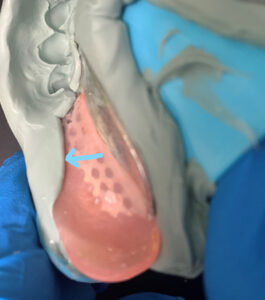
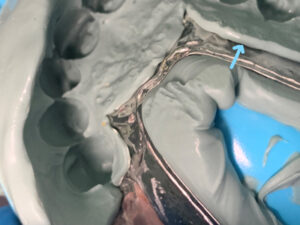
The syringe material inside this pickup impression of the cast partial did not feather out to the surrounding area. The thick roll of material indicates that the partial was not fully seated and/or that the impression material did not accurately capture the space inside.
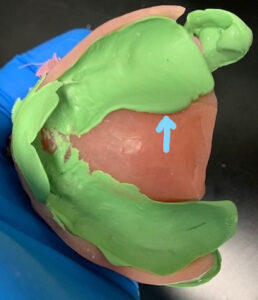
The reline inside this denture did not capture the palatal vault. Assuming that the palatal vault is okay as-is and only the ridges need to be relined, the right side material has a thick roll where it does not feather out, which indicates inaccuracy.
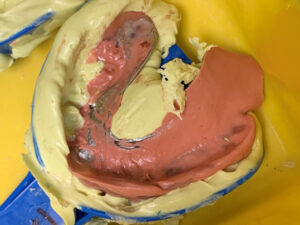
The wash impression inside the cast partial covers the metal major connector. This impression was taken to add some teeth to the right side. Because the entire left side is covered in syringe material, it is likely the left side is not fully seated. The Clinician said that the left side didn’t have any space in the intaglio and the left side did not require a reline, so there should not be any material in this area.
